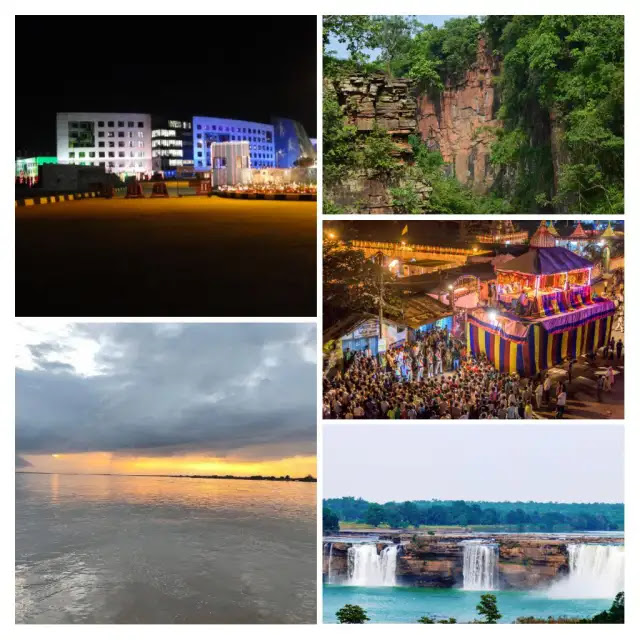Facts about Chhattisgarh: Chhattisgarh is a state in central India. Chhattisgarh, formed on November 1, 2000, is one of the most recently formed states in India. The state was formed by uniting the large districts of Madhya Pradesh. Chhattisgarh has 27 districts. Bastar is the largest district. And the small district robbery. The neighbouring states are Madhya Pradesh, Maharashtra, Andhra Pradesh, Orissa, Jharkhand and Uttar Pradesh. Raipur is the capital of Chhattisgarh. Bhupesh Bhagal is the Chief Minister. INC Chhattisgarh is ruled by a leading government.
Chhattisgarh has witnessed many battles. In the past, the region was ruled by several dynasties. Some of the places mentioned in the Ramayana and the Mahabharata are believed to be in Chhattisgarh.
In Chhattisgarh, A.D. Historical records of the dynasty from the 10th century onwards have been found. At that time the area including Chhattisgarh was under Rajput rule. The Rajput dynasty ruled the region for sixty years. By the fourteenth century the country was fragmented. Ratanpur and Raipur became separate kingdoms under two kings. In the sixteenth century there was another change of government in these areas. The Chalukya dynasty took possession of the Bastar region. Later, the Chalukya king Annam Dev ruled here for some time.
Interesting Facts about Chhattisgarh
- The ancient name of this region is Dakshin-Kausal.
- Panthi, Rawat Nacha, Saila are the main folk dances of state.
- India’s biggest waterfall is situated in Bastar, Chhattisgarh.
- Chhattisgarh accounts for 15 % of total steel production of country.
- Chhattisgarh is known as “Dhan Ka Katora” means “Rice Bowl of India”.
- Chhattisgarh accounts for 15% of total steel production of the country.
- Main festivals of the state are Pola, Nawakhai, Dussehra, Diwali, Holi and Gowardhan puja.
- The Amrit Dhara Waterfall, Koriya, is a natural waterfall which originates from the Hasdeo River.
- Chhattisgarh is the 26th state of the India and was carved out from Madhya Pradesh on Nov 1, 2000.
- The highest peak of the state is Bailadila range in Dantewada district with an altitude of 1,276 m.
- The highest peak of the state is Bailadila range in Dantewada district with an altitude of 1,276 m.
- The central part of the state lies in fertile range of Mahanadi and is gives good production of rice.
- Agricultural Products of Chhattisgarh – Tendu leaves, Chironji, harhar, baheda, mahu flowers, sal seeds.
- Dantewada is the largest district of Chhattisgarh in terms of area. Raipur is the largest by population.
- Agricultural Products of Chhattisgarh – Tendu leaves, Chironji, harhar, baheda, mahu flowers, sal seeds.
- Chhattisgarh is that it accounts for 70% of Tendu leaves production. These leaves are used to make ‘Bidis’.
- The state accounts for more than 70 % of India’s total production of “Tendu leaves” (used for making bidi).
- Mineral Resources of Chhattisgarh – Copper, Coal, Iron, Limestone, Bauxite, Dolomite, Manganese, and Diamond.
- Mineral Resources of Chhattisgarh – Copper, Coal, Iron, Limestone, Bauxite, Dolomite, Manganese, and Diamond.
- Sirpur, a perfect mélange of the Art, Heritage and History, was the capital city of the ancient Dakshin Kaushala.
- Though three big rivers Mahanadi, Godavari and Sone flows through it, there is no proper means of irrigation developed.
- Famous Kosa Silk or Tussar silk is indigenous to this state and weaved by Dewangan Communnity in Champa-Janjgir District.
- Chandulal Chandrakar of Chhattisgarh Rajya Nirman Manch played the leading role in late 90s for creation of this separate state.
- At Khairagarh one can locate India’s first University dedicated only to Music and Dance, The Indira Kala Sangeet Vishwavidyalaya.
- Chhattisgarh is one of the states with highest Schedule Tribe population. SC & ST taken together constitute 50% of States population.
- Chhattisgarh has 3 National Parks and 11 wildlife sanctuaries making it one of the most important contributors to the flora and fauna map of India.
- High Sex Ratio of 991/1000 putting it at 5th among Indian states. Talk about diversity, we are practising it and setting an example for the Nation.
- During pre-modern times this region was under the control of Marathas (Bhonsale clan of Nagpur). After that its control went to British from 1845-1947.
- Literacy rank of this state is 71.04 % which is below than national average of 74.04 %. CG comes at 20th rank in terms of literacy among Indian states.
- It is the most backward region of country but is rich minerals and earns from mining activity. Economy is mainly driven by the mineral resources of the state
- Sirpur is proposed world heritage site and Malhar are of historical significance, as they were visited by Xuanzang, the Chinese historian. Mama- bachha temple at Barsoor.
- Chhattisgarh, situated on the oldest rocks on Indian Subcontinent, is the 10th largest state of India and is also an important electricity and steel producing state of India.
- The prominent rulers of this region in the medieval times were Kalachuris from 980 to 1741 AD. Chola dynasty also attacked and ruled some part of this region in 11th century.
- Pandwani is a song and music mixed narration of incidences from Mahabharat. Teejan Bai is the popular Pandwani folk artist. This song form is famous in Chhatisgarh and Madhya Pradesh.
- Bhoramdeo temple located in Kabirdham district is considered to be built in 11th century by Nagwanshi Kings. Due to its erotic sculptures it is also called as Khajuraho of Chhattisgarh.
- Chitrkot Waterfalls is located near Jagdalpur in Bastar district. The name of its river is Indravati. Due to its large span during monsoon season it is also called as Niagra Falls of India.
- Chitrakoot Waterfalls is located near Jagdalpur in Bastar district. The name of its river is Indravati. Due to its large span during monsoon season, it is also called as Niagra Falls of India.
- It was visited by Chinese Scholar and traveller Hieun Tsang in 7th Century AD and was an important Buddhist Centre from 6th to 10th Century AD. His Highness Dalai Lama has visited this place also.
- Archaeological sites worth seeing are Barsoor in Dantewada district, Malhar and Ratanpur in Bilaspur district, Sirpur in Mahasamund district, Koriya in Koriya district and Surguja in Surguja district.
- Bhoramdeo Temple is a complex of Hindu temples dedicated to the god Shiva in Bhoramdeo, in the Indian state of Chhattisgarh. It comprises a group of four temples of which the earliest is a brick-temple.
- The state is widely appreciated for a lot of policies for food and health that the State Government has passed in favour of its people. It certainly looks a state that is concerned in its people’s welfare!
- Agriculture is the main occupation as the entire Chhattisgarh is well irrigated by various rivers like Mahanadi, Shivnath, Hasdeo, Arpa, Indravati, Rihand etc making Chhattisgarh as the Rice Bowl of India.
- It borders with 7 states – Uttar Pradesh in the north, Jharkhand in the northeast, Odisha in the east, Andhra Pradesh in the south, Telangana in the southwest, Maharashtra in the west, Madhya Pradesh in the northwest.
- Bastar Dushehra is one among the most known Dushehras In India. Two others are Kullu Dushehra and Mysore Dushehra. Festive mood during 75 days long Dushehra Celebration can be compared to Tomatino and Rio Carnival of the world.
- Gadiya Mountain in Kanker district, Kotumsar cave in Bastar district, Kailash gufa in Jashpur district, Ramgarh and Sita Bengra in Surguja district and Singhanpur cave in Raigarh district with pre-historic paintings are well known.
- Main Industries of Chhattisgarh – most of the industries are mineral based like BALCO, Bhilai Steel Plant. The well known Baldia mines, lot of power projects, Steel plant of Bhilai and many other cement factories belong to this state.
- Main Industries of Chhattisgarh – most of the industries are mineral based like BALCO, Bhilai Steel Plant. The well-known Baldia mines, a lot of power projects, Steel plant of Bhilai and many other cement factories belong to this state.
- Home to India’s own Niagara: Horse shoe pattern water fall at Chitrakote is the largest water fall of India. Its gushing water creates most mesmerizing experience to eyes and fills the soul with thrill. Its best seen right after Monsoon.
- Chhattisgarh is the land where our own Lord Rama walked on during his exile and it was known as Dakshin Kaushla in ancient times. Many places such as Seorinarayan, Ram Tekri, Ramgarh, Sita Bengra and many more places falls on Rama Van Gaman Marg.
- It is home to more than 40 indigenous tribes still sustaining with their age old traditions and customs. Each tribal group has distinct traditions, rituals and customs giving Chhattisgarh a unique identity and making it ideal place for tribal tourism.
- Its home to a large Tibetan Population at Mainpat, also known as the Shimla of Chhattisgarh, offers some of the enchanting views of nature and is home to only Buddha Temple of Chhattisgarh. His Highness Dalai Lama has visited this place ensuring a permanent place for Mainpat in Tibetan History.
- Ramgarh in Surguja is where one can locate world’s oldest Theatre. Sita Bengra, where Sita is believed to spend time during her exile with Ram and Laxman, is recognised as the oldest Natyashala where legendary Poet and Drama writer Kalidas is believed to have stayed for few years while penning down his Meghdoot.
- Thanks to the recorded forest cover of 40% which offers immense bio-diversity to Chhattisgarh and thus bestow it with a very vibrant wild life. Achanakmar Tiger Reserve, Kanger Valley National Park, Barnawapara Wildlife Sanctuary and Udanti-Sitandi Wildlife Sanctuary are known for wilderness and natural beauty and home to many rare and endangered species.
- The hot spring is known as Taat Pani, (taat – hot, pani – water) the hot spring flows in Balrampur district. This hot spring flows throughout the year and is reputed to have medicinal properties due to its high sodium content. National Thermal Power Corporation Limited is developing a geothermal power plant at Taat Pani, which is described as the first geothermal power plant in India.
- Kawardha is a Treasure Trove of breathtaking scenery & fascinating reminders of India’s rich cultural heritage. This lovely property was built in the 1930s by Maharaj Dharamraj Singh using the best Italian marble and stone, stands out in the 11 acres of lush green garden. It is more of a private guest house than of a hotel, which is rich in memories style, and history. This palace belongs to the Royal family of Kawardha State.
Friends, hope you liked this post of Amazing Facts about Chhattisgarh. If you liked this post, then you must share it with your friends and Subscribe to us to get updates from our blog. Friends, If you liked our site FactsCrush.Com, then you should Bookmark it as well.














0 Comments